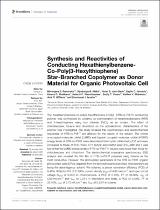| dc.contributor.author | Ramoroka, Morongwa E. | |
| dc.contributor.author | Mdluli, Siyabonga B. | |
| dc.contributor.author | John-Denk, Vivian S. | |
| dc.date.accessioned | 2022-07-26T08:05:17Z | |
| dc.date.available | 2022-07-26T08:05:17Z | |
| dc.date.issued | 2022 | |
| dc.identifier.citation | Ramoroka, M. E. et al. (2022). Synthesis and reactivities of conducting hexathienylbenzene-co-poly(3-hexylthiophene) star-branched copolymer as donor material for organic photovoltaic cell. Frontiers in Materials, 9, 856008. 10.3389/fmats.2022.856008 | en_US |
| dc.identifier.issn | 2296-8016 | |
| dc.identifier.uri | https://doi.org/10.3389/fmats.2022.856008 | |
| dc.identifier.uri | http://hdl.handle.net/10566/7628 | |
| dc.description.abstract | The hexathienylbenzene-co-poly(3-hexylthiophene-2,5diyl) (HTB-co-P3HT) conducting
polymer was synthesized by oxidative co-polymerization of hexathienylbenzene (HTB)
and 3-hexylthiophene using iron chloride (FeCl3) as an oxidant. The effect of
chlorobenzene, toluene and chloroform on the optoelectronic characteristics of the
polymer was investigated. The study revealed that spectroscopic and electrochemical
responses of HTB-co-P3HT are affected by the nature of the solvent. The lowest
unoccupied molecular orbital (LUMO) and highest occupied molecular orbital (HOMO)
energy levels of HTB-co-P3HT were determined from cyclic voltammetry (CV) and were
compared to those of (6,6)-Phenyl C71 butyric acid methyl ester (PC71BM) and it was
found that the LUMO energy levels of HTB-co-P3HT in toluene were lower than those for
chlorobenzene and chloroform. | en_US |
| dc.language.iso | en | en_US |
| dc.publisher | Frontiers Media | en_US |
| dc.subject | Organic photovoltaic cells | en_US |
| dc.subject | Solar cell | en_US |
| dc.subject | Chemistry | en_US |
| dc.subject | Benzene | en_US |
| dc.title | Synthesis and reactivities of conducting hexathienylbenzene-co-poly(3-hexylthiophene) star-branched copolymer as donor material for organic photovoltaic cell | en_US |
| dc.type | Article | en_US |

